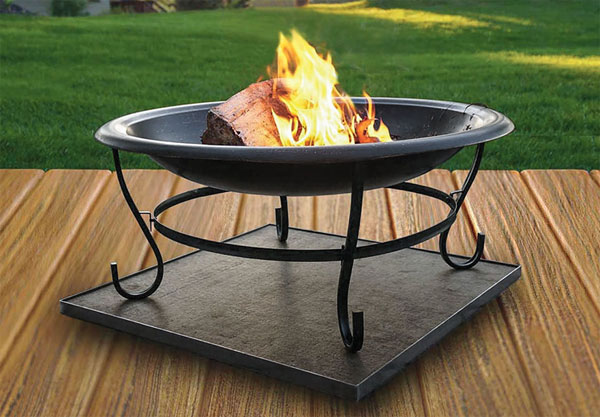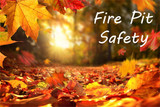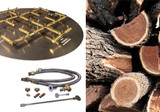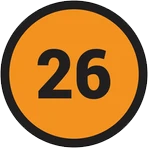Safety When Using a Fire Pit on a Wood Deck
Can You Safely Use a Fire Pit on a Wood Deck?
Fire pits are a popular addition to outdoor living spaces, bringing warmth, ambiance, and a cozy focal point for gatherings. But when you place a fire pit on a wood deck, the risk of fire, heat damage, and injury increases dramatically.
The good news? With the right setup, precautions, and maintenance, you can safely use a fire pit on a wooden deck. This guide covers the 4 critical do’s and don’ts to protect your home, family, and deck while enjoying the magic of a fire pit.
✅ DO #1: Choose a Fire Pit That’s Safe for Deck Use
Why It Matters:
Not all fire pits are safe for wooden surfaces. Choosing the wrong type increases the risk of heat damage or even deck fires.
? What to Look For:
-
Deck-safe fire pits: Look for models labeled CSA-certified or deck-compatible.
-
Gas-powered fire pits: Propane or natural gas models are safer for decks than traditional wood-burning fire pits.
-
Heat shields and insulation: Choose a fire pit with a base that prevents heat transfer to the deck.
-
Raised or table-style fire pits: These models keep flames and heat well above the surface.
✅ Pro Tip:
Avoid DIY fire pits on a deck. Commercial models are tested for safety—homemade versions often aren’t.
❌ DON’T #1: Place the Fire Pit Directly on the Wood Deck
Why It Matters:
Wood is a combustible material. Placing a fire pit directly on your deck can lead to scorching, heat damage, or worse—fire.
? What to Avoid:
-
No direct contact between the fire pit and the deck.
-
Avoid flammable or meltable mats underneath.
-
Don’t overlook the area beneath your deck—embers can fall through and ignite hidden debris.
✅ What to Do Instead:
-
Use a fire pit pad, heat-resistant mat, or paver stones underneath.
-
Install a non-combustible base on your deck (like stone tiles).
-
Regularly inspect the decking under the pit for damage.
✅ DO #2: Maintain a Safe Distance and Clear Area
Why It Matters:
Flames, radiant heat, and flying embers can easily ignite nearby furniture, railings, or decorations.
✅ Safety Guidelines:
-
Maintain 10+ feet of clearance around the fire pit.
-
Keep outdoor furniture, plants, and umbrellas far from the flames.
-
Use a spark screen to contain embers—especially for wood-burning fire pits.
✅ Pro Tip:
Windy day? Skip the fire. Even small embers can blow onto your house or into nearby landscaping.
❌ DON’T #2: Leave the Fire Pit Unattended
Why It Matters:
Unattended fires are one of the most common causes of deck fires. Even embers can reignite hours after flames go out.
? Never Do This:
-
Don’t walk away from a burning or smoldering fire pit.
-
Never assume a fire is “out” because you don’t see flames.
-
Don’t go to sleep with coals still hot.
✅ Best Practices:
-
Completely extinguish the fire with water, sand, or a snuffer lid.
-
Use a fireproof cover when not in use.
-
Keep a fire extinguisher, garden hose, or bucket of sand nearby.
✅ DO #3: Follow Local Fire Codes and Insurance Guidelines
Why It Matters:
Many cities, counties, and homeowners’ associations (HOAs) have regulations about fire pits, especially on wooden decks. Ignoring them could result in fines or denied insurance claims.
✅ What to Do:
-
Check your local fire code. Some areas ban open flames on decks.
-
Confirm with your HOA. There may be restrictions on fire pit types or usage.
-
Contact your insurer. Make sure your policy covers deck fire pit usage.
✅ Pro Tip:
During drought or high winds, even legal fire pits may be prohibited under temporary burn bans.
❌ DON’T #3: Use Gasoline or Wet Wood to Start a Fire
Why It Matters:
Accelerants like gasoline or lighter fluid can cause explosions or uncontrollable flare-ups. Wet or green wood produces excessive smoke and embers.
? Avoid:
-
Gasoline, lighter fluid, or alcohol
-
Burning trash, plastics, or pressure-treated lumber
-
Overloading the fire pit with large logs
✅ Safer Alternatives:
-
Use kiln-dried hardwoods like oak or maple
-
Start fires with natural fire starters or fatwood
-
Keep the fire small and contained
✅ DO #4: Protect Children, Pets, and Guests
Why It Matters:
Fire pits on decks are inviting—but they can also be dangerous if people or pets get too close, especially at night.
✅ How to Stay Safe:
-
Create a "no-go zone" around the fire with furniture or low fencing.
-
Supervise kids and pets at all times.
-
Use solar or LED deck lighting for better visibility.
✅ Extra Caution:
Choose fire pits with cool-touch exteriors or tempered glass wind guards to reduce the risk of burns.
❌ DON’T #4: Neglect Maintenance of the Fire Pit or Deck
Why It Matters:
Weather, age, and constant use take a toll on both your deck and your fire pit. Cracks, rust, or warping can become serious hazards.
? Don’t Do This:
-
Don’t use a rusty or damaged fire pit
-
Don’t ignore scorched deck boards or soft spots
-
Don’t allow ash buildup
✅ Maintenance Tips:
-
Inspect before each use: Look for rust, cracks, or instability.
-
Clean regularly: Remove ashes and debris after each burn.
-
Seal your deck annually: A sealed deck is more heat- and weather-resistant.
Enjoy Your Fire Pit—Safely
Using a fire pit on a wooden deck can be both beautiful and practical, but it comes with real risks. The key is to prioritize safety, smart setup, and ongoing maintenance.
By following these 4 do’s and don’ts, you’ll enjoy countless cozy evenings with peace of mind, knowing your deck is protected and your fire pit setup is compliant, clean, and safe.
? Bonus: Quick Checklist for Fire Pit Safety on Wood Decks
✅ Choose a deck-safe, insulated fire pit
✅ Use a fire-resistant pad or pavers
✅ Keep 10 feet of clearance from all flammables
✅ Never leave a fire unattended
✅ Use dry, untreated hardwood
✅ Follow local codes and HOA rules
✅ Supervise children and pets
✅ Inspect the fire pit and deck regularly
FAQs About Fire Pits on Wood Decks
❓Can you put a fire pit on a wood deck?
Yes, but it must be deck-safe, raised, and properly insulated with a fireproof barrier underneath.
❓What’s the safest fire pit for a wooden deck?
Propane fire pits with insulated bases or fire tables are the safest options.
❓Do I need a fire pit mat on a wood deck?
Absolutely. Fire pit mats or pads protect against heat transfer and potential ignition.
Fire Pit Tips, Product Guides & Outdoor Living Advice
Fire Pit Safety Tips Every Homeowner Should Know
There’s something undeniably magical about kicking back in your backyard next to a warm crackling fi...
Gas vs Wood Fire Pits: Which One Fits Your Lifestyle
If you're thinking about adding a fire pit to your backyard, you’ve probably run into the classic de...
How to Choose the Perfect Fire Pit for Your Outdoor Space
Creating an inviting outdoor living area has never been more popular, especially as homeowners seek...
The Proper Gas and Wood Fire Pit Height - The Best Seating Guide for Comfort
Outdoor fire pits are a beloved focal point for patios, backyards, and gathering spaces. Whether fl...
Safety When Using a Fire Pit on a Wood Deck
Can You Safely Use a Fire Pit on a Wood Deck? Fire pits are a popular addition to outdoor living sp...
Top Fire Pit Trends for 2025
There’s nothing quite like gathering around a fire pit with friends and family, roasting marshmallow...









